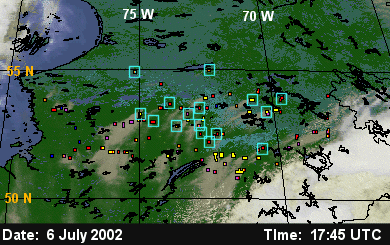
[ Archive ]

 |
CIMSS-NOAA Weekly Report
[ Archive ] |
 |
IN THE PRESS:
ITEMS FOR THE ADMINISTRATOR:
ITEMS FOR THE ASSISTANT ADMINISTRATOR:
ITEMS FOR THE OFFICE DIRECTOR, ORA:
CIMSS Science
Council Meeting: The Science Council of the Cooperative
Institute for Meteorological Satellite Studies (CIMSS) held its annual
meeting on September 3, 2003. Fran Holt and Arnie Gruber are
members of the Science Council and were in attendance. (J. Key, E/RA2,
608-263-2605)
Meeting on GOES-R Synergy: T. Schmit
attended
a Geostationary Operational Environmental
Satellite (GOES)-R Instrument Synergy sub-group meeting at the
Massachusetts
Institute of Technology /Linclon Lab (MIT/LL). The meeting covered many
aspects of GOES-R synergy: Intra-Satellite (e.g., next generation
imager and sounder),
Intra-System (e.g., East and West geostationary), and Inter-System
(e.g.,
GOES-R/National Polar Orbiter Environmental Satellite System
(NPOESS)). The group focused on Intra-Satellite uses; for
example, how might data/products from the Hyperspectral Environmental
Suite-Infrared (HES) and -Coastal Waters (HES-IR and HES-CW) and the
Advanced Baseline Imager (ABI)
help each other and how might this be accomplished. (T. Schmit, E/RA2,
608-263-0291)
ITEMS FOR THE DIVISION CHIEF, ARAD:
GOES Wildfire
ABBA Validation Study in Quebec: As part of a multi-year
collaboration with M. Moreau (Environment Canada/Meteorological
Services/Quebec Region) the Geostationary Operational Environmental
Satellite Wildfire Automated Biomass Burning Algorithm (WF_ABBA) fire
products for the 2002 fire season were compared with available ground
truth information provided by SOPFEU (SOciété de
Protection des forêts contre le FEU), Quebec’s forest fire
detection and prevention agency. When considering fires that
burned more than 10 hectares, the ABBA detected 91 out of 111 reported
fires and a number of additional fires that were not reported due their
remote location where there is no systematic daily reporting. In
one case the WF_ABBA detected a fire 17 days in advance of the first
fire agency report; this fire eventually burned more than 55,000
hectares. This study shows the utility of diurnal remote sensing
fire products in remote areas at northerly latitudes. (J. Feltz, CIMSS,
608-263-3434, E. Prins, E/RA2, 530-271-2256, C. Schmidt, CIMSS,
608-262-7973)

Figure Caption: This alpha-blended composite for 17:45 UTC on
July 6, 2002 shows fires that were detected by the GOES-8 WF_ABBA in
Quebec Canada prior to the initial fire agency report. These
fires are located in the restricted protective zone of Quebec, where
there is no daily systematic detection capability.
Fire Product Assimilation Proposal Funded by NASA: A proposal titled “Analysis of Real Time Biomass-Burning Transport Model Data with Remote Sensing Products” was funded by the NASA’s Earth Observing System InterDisciplinary Science (EOS/IDS) Earth Science Enterprise’s Modeling and Data Analysis Research program. The Principal Investigator is J. Reid of the Naval Research Laboratory (NRL-Monterey) with D. Westphal (NRL-Monterey) and E. Prins serving as Co-PI’s. This effort is an extension of a 3-year study focused on assimilating real-time fire products into the Naval Aerosol Analysis and Prediction System (NAAPS) to diagnose and predict aerosol loading and transport in real time. Part of this proposal includes future assimilation of global geostationary fire products and integration with current and future NASA EOS and international satellite-derived aerosol and trace gas products (e.g. ozone, carbon monoxide, methane, aerosols). (E. Prins, E/RA2, 530-271-2256, C. Schmidt, CIMSS, 608-262-7973, J. Feltz, CIMSS, 608-263-3434)
Biomass Burning Extended Abstracts Submitted to AMS Conference: Members of the Cooperative Institute for Meteorological Satellite Studies (CIMSS) Biomass Burning Monitoring Team submitted extended abstracts to the 2nd International Wildland Fire Ecology and Fire Management Congress, part of the American Meteorological Society's (AMS) 5th Symposium on Fire and Forest Meteorology to be held November 16-20, 2003 in Orlando, Florida. One extended abstract describes a validation study which is part of an international collaborative effort. "Recent validation studies of the GOES Wildfire Automated Biomass Burning Algorithm (WF_ABBA) in North and South America" was submitted by Joleen Feltz, Michel Moreau (Environment Canada/Meteorological Services/Quebec region), Elaine M. Prins, Kirsten McClaid-Cook (State University of New York-SUNY, Albany), and Irving F. Brown (Woods Hole Research Center, Federal University of Acre, Brazil). The second abstract, "GOES Wildfire ABBA Applications in the Western Hemisphere", submitted by Christopher C. Schmidt and Elaine M. Prins, discusses the WF_ABBA algorithm, its output, and the efforts to reduce the time it takes to produce the product. (C. Schmidt, CIMSS, 608-262-7973, J. Feltz, CIMSS, 608-263-3434, E. Prins, E/RA2, 530-271-2256)
Manuscript
Reviewed: J. Key reviewed a manuscript on surface temperature
retrieval and atmospheric correction for the journal Photogrammetric Engineering and Remote
Sensing.
(J. Key, E/RA2,
608-263-2605)